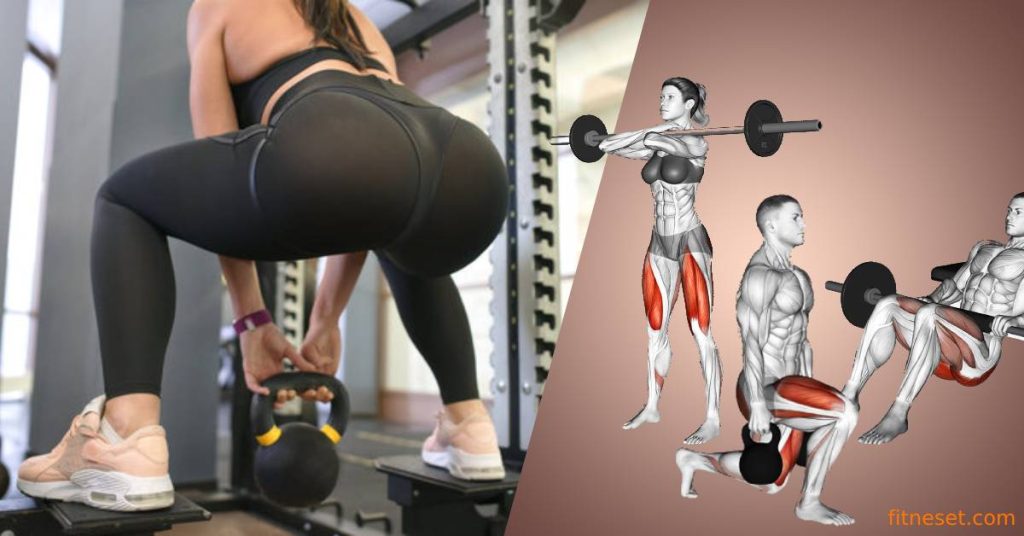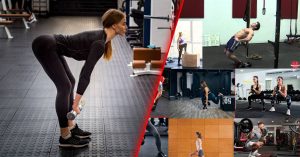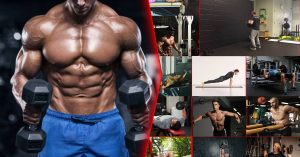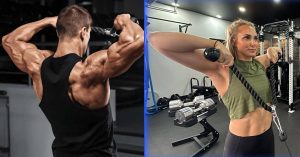Have you ever hit a wall with your squats, wondering how to push past and turbocharge your muscle growth? The secret might just be in the best squat accessories and a selection of focused accessory exercises.
Squatting is more than just a game of how much weight you can lift. It’s a complex dance of muscles that, when paired with the right accessories, can lead to impressive gains in both muscle strength and size.
The best squat accessories do more than just boost your squat numbers; they also prevent injuries by ensuring balanced muscle development across your body. So, why wait any longer? Let’s dive in and explore how these accessories can transform your training.
Table of contents
MORE keyboard_double_arrow_down LESS keyboard_double_arrow_up
What Are the Best Squat Accessories Exercises?

1. Barbell Good Morning
Good mornings are a challenging exercise that works your glutes, hamstrings, and lower back at the same time. Be careful, especially if you don’t have a special safety bar, because you need to hold the weight in a precarious position.
But if you do it right, barbell good mornings can help strengthen your lower back and improve your squat. They also make your hamstrings looser and your glutes and back muscles stronger.
Here’s how to do them:
- Set up the weight like you would for a squat.
- Hold the weight on your upper back and walk back a few steps.
- Bend over at your hips, keeping your chest up and shoulders down, until your back is almost flat.
- Squeeze your back and hamstrings to stand back up.
Remember, start with a light weight and be careful with your form!
2. Front-Rack Kettlebell Elevated Split Squat
This exercise is like a super squat that builds even more strength and helps you squat heavier.
Here is why:
- Works both legs equally, ironing out any weaknesses.
- Strengthens your push-off power for heavier squats.
- The kettlebell placement targets your front leg muscles more.
- The kettlebell trains your core, upper back, and posture.
How to Do It:
- Grab two kettlebells and hold them in front of your shoulders (clean position).
- Stand tall with one foot forward and the other laces-down on a bench.
- Lean forward slightly and lower your back knee towards the floor.
- Push through your front foot to stand back up, squeezing your butt muscle.
- Repeat, then switch legs.
Tip: Start with lighter weights and focus on proper form before adding more weight.
Enjoy stronger squats and better overall fitness with this challenging exercise!
3. Back Extensions
Back extensions are a great way to strengthen your lower back, glutes, and hamstrings, all of which are crucial for powerful squats and good posture. You can do them on a machine, bench, or even on the floor with your own bodyweight.
Why do them?
- This exercise strengthens your lower back muscles through a full range of motion, leading to better overall strength and muscle growth.
- Strong lower back and hamstrings are key for powerful squats. Back extensions target both, helping you lift heavier and with better form.
- Back extensions help keep your spine in a healthy alignment, improving your posture and reducing the risk of pain.
How to do them:
- Find your setup: You can use a back extension machine, glute-ham raise bench, or simply lie on your stomach on the floor.
- Secure your body: If using a machine, lock your feet in place. On the floor, lie flat with your arms crossed across your chest or holding a weight plate for added resistance.
- Lower and lift: Slowly lower your upper body down until your back is parallel or slightly below the floor. Keep your core engaged and avoid arching your back. Then, use your glutes and lower back muscles to raise your torso back up to the starting position.
- Repeat: Do 10-15 repetitions for 2-3 sets.
Remember: Start with a lighter weight or no weight at all if you’re new to the exercise. Focus on proper form over lifting heavy. With consistent practice, back extensions can become a valuable tool for improving your squat strength and overall fitness.
4. Ab Rollout
Ready to take your squats to the next level? Look no further than the ab rollout! This exercise strengthens your core in a unique way that directly translates to better, safer squats.
Why it matters:
- This exercise trains your core to resist your back from rounding under heavy loads, like a squat bar.
- Both extending and rolling back work your core muscles, leading to better overall development.
- Choose from barbells, ab wheels, or stability balls to keep your core routine fresh.
Here’s how to do:
- Kneel tall: Grab your chosen equipment and kneel with your back straight and shoulder blades open.
- Engage your core: Tuck your hips slightly and brace your abs like you’re about to be punched.
- Roll out: Slowly extend your torso forward, keeping your lower back flat and chest close to the ground. Control the movement – don’t let your body go limp.
- Roll back: Squeeze your core and pull yourself back to the starting position.
- Repeat: Do 10-15 reps for 2-3 sets.
Start slow and light, focusing on proper form over heavier weights. With consistent practice, the ab rollout will become a core staple for powerful and safe squats!
5. TRX Y
Squatting heavy? Your upper back is key! It keeps your spine in check and prevents your squat from turning into a “good morning.” Plus, a strong back creates a stable platform for the barbell.
The TRX Y targets your shoulder muscles, especially the upper traps and rhomboids, leading to better mobility and posture.
Why it stands out:
- Hits your upper back from a different angle for well-rounded development.
- Strengthens your rhomboids and traps for better shoulder mobility and stability.
Here’s how to do it:
- Grab the TRX handles firmly. Step closer or further from the anchor point depending on how challenging you want it.
- Keep your shoulders relaxed and down.
- Raise your arms overhead in a Y shape, keeping them close to your ears.
- Slowly lower your arms down and then return to the start. Repeat!
6. Pause Squat
The pause squat might not be everyone’s favorite exercise, but it’s undeniably effective. Pausing at the bottom builds serious strength, stability, and confidence. Why?
- You have to “own” the bottom position, where weaknesses often hide. This builds strength and confidence for heavier squats.
- Removing the stretch reflex forces you to use pure muscle power to stand up, making the lift more challenging and improving your leg drive.
Here’s how to do it:
- Set up your barbell squat with a weight around 70-80% of your one-rep max.
- Go to your usual depth and then hold it for 3-5 seconds. Keep your body tight and engaged.
- Stand up explosively using your leg muscles, not momentum.
- Do sets and reps based on your program.
- Start light and focus on proper form before adding weight. Embrace the pause and watch your squat progress soar!
7. Sissy Squat
Sissy squats sound funny, but don’t underestimate their power! This simple bodyweight exercise is a quad-building machine, perfect for anyone wanting stronger legs and better squats. Why?
- Forget fancy equipment – sissy squats directly target your quads, building strength and size.
- Bigger quads support your knees, increasing their resilience and helping you squat with confidence.
- Keeping your balance during sissy squats improves fine motor control, benefiting all your workouts.
- The deep range of motion in sissy squats maximizes your quad-building potential.
Ready to give it a go? Here’s how to do it:
- Stand tall with feet hip-width apart.
- Squat down by pushing your knees straight forward and leaning back slightly. Imagine sinking into a chair that’s way behind you.
- Go as low as your balance and hip extension allow, keeping your back straight.
- Push yourself back up to the starting position and repeat!
What Muscles Are Worked by the Squat?
The squat is a powerhouse movement engaging a multitude of muscles across the body:
- Upper Back: Provides stability and support for the barbell.
- Core: Acts as a stabilizer throughout the movement.
- Glutes and Hamstrings: Drive the upward phase of the squat.
- Quads: Essential for knee extension and overall power.
Recognizing the role of each muscle group in the squat is crucial for selecting the right accessory exercises. By incorporating a mix of squat and deadlift accessories, you can address any imbalances, ensuring a harmonious development of strength and muscle.
How Can You Program Squat Accessory Training?
Incorporating accessory exercises into your squat routine requires a strategic approach:
- Start Small: Begin with two to three accessory exercises per session, targeting different muscle groups.
- Include Deadlift Accessories: These are vital for a comprehensive lower body workout, enhancing both squat and deadlift performance.
- Balance Is Key: Ensure your program covers all bases, from strength to stability and mobility.
Squat Accessory Exercise Selection: Tailoring Your Workout
Tailoring your workout to your specific needs is essential for maximizing squat performance:
- Opt for Pause Squats and Anderson Squats to build strength and confidence in the hole.
- Incorporate accessory exercises for deadlifts to bolster your squat indirectly.
This customized approach ensures you’re not just working hard but also working smart, focusing on areas that need the most attention and improvement. But how do you determine these areas of focus? The key lies in constant self-assessment and adjustment based on progress and feedback.
Squat Accessory Sets and Reps
Determining the ideal sets and reps for your accessory exercises can significantly impact your training outcomes:
- For Strength: Aim for three to five sets of six to eight reps.
- For Muscle Growth: Target three to four sets of eight to 15 reps.
- Adapting Intensity: Adjust the load according to your training phase and goals.
Training Tips and Advice
To optimize your squat training, a strategic mix of exercises is essential. Here’s how you can enhance your routine:
- Incorporate exercises like lunges and single-leg squats. These movements help correct imbalances between legs, ensuring equal strength and mobility.
- A strong core is the foundation of a powerful squat. Include exercises like planks and leg raises to build a core that can support heavy lifts.
- Mix your routine with both squat and deadlift accessories. This variety not only prevents boredom but also ensures comprehensive muscle development.
Conclusion
Mastering the squat is an ambitious goal, but with the right approach, it’s within your reach. By incorporating the best squat accessories and deadlift accessories, you create a robust training regimen that covers all bases.
But what does this journey look like for you? How will these changes impact your training sessions and overall progress? There’s only one way to find out. Dive into the world of best squat accessories, embrace the challenge, and watch as your strength and muscle growth soar to new heights.
Key Points
- To maximize squat performance, include both squat and deadlift accessory exercises in your training routine.
- Utilize unilateral exercises such as lunges and single-leg squats to correct imbalances and ensure equal strength development.
- Core strength is essential for a powerful squat, so include core-specific exercises like planks and leg raises.
- Select accessory exercises based on your personal goals and weaknesses, such as pause squats for improving bottom position strength.
- For muscle growth, aim for 3-4 sets of 8-15 reps; for strength, 3-5 sets of 6-8 reps; and beginners should focus on technique with up to 3 sets of 10 reps.
- Combine squats with presses, rows with deadlifts, and back with quads exercises for a balanced workout.
- Holding a light plate or dumbbell at chest level can add resistance and engage more muscles during squats.
- Start with 2-3 sets of 15 reps of squats every other day, gradually increasing to more reps as fitness improves.
- For those seeking a challenge, performing 100 squats daily for a month can significantly enhance endurance and strength.
FAQs
What Should I Pair with Squats?
When looking to complement your squat routine, consider pairing different muscle groups and movements to maximize your workout efficiency. Here are some effective pairings:
- Squats and Presses: This combination targets your lower body and upper body, ensuring a balanced workout.
- Rows and Deadlifts: Pairing these can enhance your back strength and improve your posture for squats.
- Back and Quads: Working on your back and quads together can lead to improved stability and squat performance.
- Shoulders and Hamstrings: This pairing focuses on building strength in both the upper and lower body, contributing to a stronger squat.
What Should I Hold When Doing Squats?
For added resistance and to engage more muscles during squats, you can hold a light plate or dumbbell at chest level. Here’s how to do it:
- Position: Hold a light plate or dumbbell by its sides at chest level, ensuring your elbows are pointing out and down.
- Stance: Stand with your feet shoulder- to hip-width apart.
- Movement: As you squat, sit your hips back and bend your knees. Drop into a deep squat, allowing your elbows to come inside your knees and push them out.
What Is the Best Set for Squats?
The ideal set and rep range for squats depend on your fitness goals:
- To Build Muscle: Aim for 4 to 5 sets of 6 to 8 reps with a moderately heavy weight.
- To Gain Strength: Perform 3 to 8 sets of 3 to 5 reps with heavy but manageable weight.
- For Beginners: Start with 3 sets of up to 10 reps with light weight to focus on technique.
How Many Squats Is Best?
The number of squats that is best for you depends on your current fitness level and goals:
- For Beginners: Start with 2–3 sets of 15 reps every other day. As you progress, you can increase to 3 sets of 20 reps every other day.
- For a Fitness Challenge: Try doing 100 squats every day for 30 days to challenge yourself and build endurance.
Remember, consistency and proper form are key to getting the best results from your squat routine. Adjust the volume and intensity based on your progress and how your body responds to the training.

ABOUT THE AUTHOR
Follow Valen Steven for a dose of fitness enthusiasm, evidence-based advice, and a roadmap to achieving your health and wellness goals.
Subscribe to our Newsletter
Dive into a world of fitness and wellness with our exclusive newsletter! Sign up now and receive weekly power-packs of fitness wisdom




